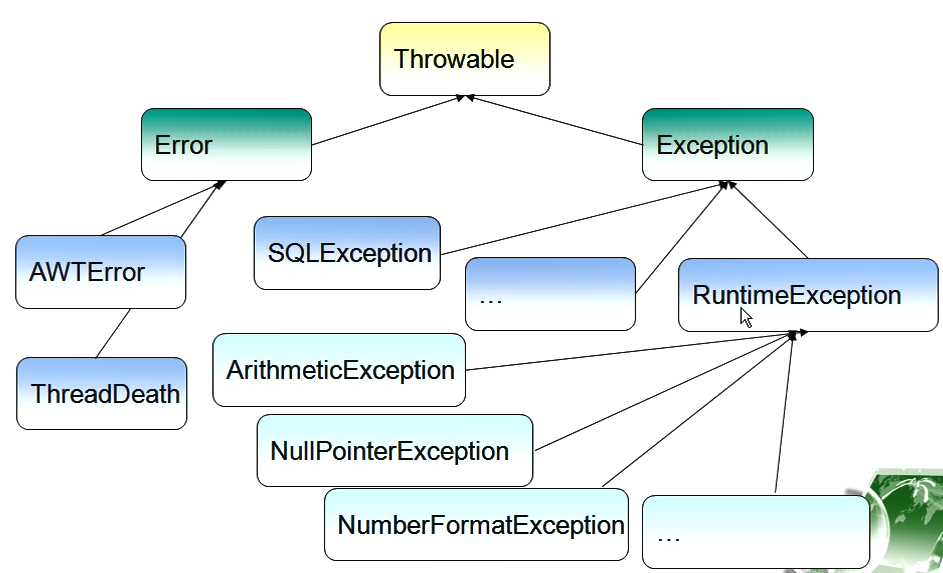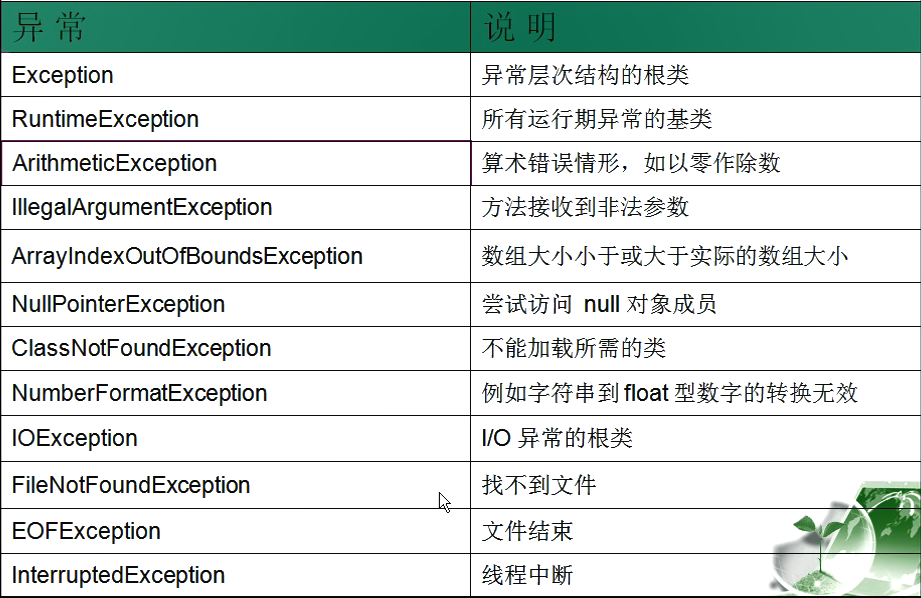一、异常的概念
异常、错误的概念以及区别
- 异常是不正常的事件,不是错误
- 异常是指程序运行的过程中,发生某些以外的事故,比如 10 除以 0,文件不存在等
二、错误的概念
- 错误是比较难处理的,比如内存溢出,不能通过异常处理机制来解决

- 异常的程序中发生的不正常事件流,通过处理程序依然可以运行下去。但是错误无法控制,程序肯定会中断
三、API 中的异常
3.1 异常的体系
Throwab le类有两个直接子类: Exception类、Error类。Error表示错误,可能是编译期错误或者系统错误,往往 程序中并不处理。Exception表示异常, 是所有异常类的父类,是程序员所关心的。
3.2 异常的种类
- 异常分为 运行期异常 和 编译期异常两种
四、异常捕获 (try catch finally)
4.1 try 的定义和使用
- 检测不安全的代码库 (发现异常)
- try 块中任何一条语句发生了异常,下面的代码将不会执行,程序将不会被执行,程序将跳到异常处理的代码块中,即 catch 块。因此不能随意将不相关的代码放到 try块中,因为随时可能中断执行
try {代码块}
4.2 catch的定义和使用
- 把抓到的类型匹配的异常捕获,保证程序可以正常运行下去
- catch 语句必须紧跟着 try 语句,称为捕获异常,也就是异常处理函数,一个 try 后面可以写多个 catch,分别捕获不同类型的异常,要从子类往父类顺序写,否则有编译错误
catch (异常类型 引用名) {}// catch 可以跟多个try {xxxx} catch (NullPointerException e) { // 捕获子类异常} catch (Exception e) { // 捕获父类异常}
4.3 finally的定义和使用
- finally 改内容总是会执行,而且只能有一个 finally 语句
finally {必须执行的逻辑}
4.4 基本语法
try {可能发生的异常代码} catch (异常类型 引用名) {异常处理代码} finally {必须执行代码}
try {String a = null ;System.out.println(a.split("a")) ;System.out.println("执行 try 语句");} catch (NullPointerException e) {System.out.println("空指针异常");e.printStackTrace() ;} catch (Exception e) {System.out.println("发生异常了");e.printStackTrace();} finally {System.out.println("执行结束");}

五、finally 和 return
finally 是强制执行,无论如何 finally 都会执行,然后才会执行 return
5.1 return 会阻止 finally 执行吗?
main 方法省略,只写核心代码try {System.out.println("执行 try 语句");String a = null ;System.out.println(a.length()) ;return ;} catch (NullPointerException e) {System.out.println("空指针异常");} finally {System.out.println("执行结束");}System.out.println("main 结束了");

5.2 强制退出 System.exit(0)
try {
System.out.println("执行 try 语句");
String a = null ;
System.out.println(a.length()) ;
} catch (NullPointerException e) {
System.out.println("空指针异常");
System.exit(0); // 强制退出 JVM 虚拟机
System.out.println("我不会执行了");
} finally {
System.out.println("执行结束");
}
System.out.println("main 结束了");
六、throw 和 thorws、层层抛出异常
6.1 thorw
- throw 用于显示抛出异常
- 抛出异常后处理
- 使用 try-catch 捕获异常
- 使用 throws 声明异常
- 语法 throw new 异常类构造方法
例如 throw new Exception();
利用抛出异常来标记不正常的事件,从而对事件流统一处理
static int avg(int n1, int n2) throws Exception {
if (n1<0 || n2<0) // 判断是否满足条件
{
throw new Exception("不能使用负数");
}
if (n1>100 || n2>100) {
throw new Exception("数值太大了!");
}
return (n1+n2)/2;
}
6.2 throws
- 用于方法声明处,指出方法引出的异常
- 可以声明多种异常类型,用逗号分开即可
- 示例
public void test throws NullPointerException,Exception.... {
}
- 任何方法都可以使用 throws 关键字声明异常类型,包括抽象方法
- 子类覆盖父类中的方法,子类方法不能声明抛出比父类范围更大的异常
- 使用了 throws 方法,调用时必须处理声明的异常,要么使用 try-catch,要么继续使用 throws
6.3 层层抛出异常举例
public class cal {
//除法计算
//b不能为0
public void calc(int a,int b) throws Exception {
if(b==0){
try {
throw new Exception("有异常哦!!!!");
} catch (Exception e) {
System.out.println("有异常哦!!!!");
//现在这里抛出一个有异常的提示,具体的异常可在调用时再抛出
throw e;
}
}
else{
System.out.println(a/b);
}
}
}
public class io异常 {
public static void main(String[] args)throws Exception{
cal ac=new cal();
try {
ac.calc(5,0);
} catch (Exception e) {
System.out.println("输入的除数不能为0!!!!");
}
}
}
6.3 总结
- 自定义异常类
- 自定义异常类往往不写其他方法,只重载需要使用的构造方法
// 该类中不会写方法 public class 异常类名 extends Exception { public 异常类名(String msg) { super(msg); } }}




